Different Types of ROM
The different types of ROMs will also help you understand how they’re used for different applications, and which type may apply to your application.
The different types of ROM used in the industry are:
- PROM (Programmable ROM)
- EPROM (Erasable Programmable ROM)
- EEPROM (electrically erasable programmable ROM)
- Flash EPROM
- Mask ROM
1. PROM (programmable ROM) and OTP
PROM refers to the kind of ROM that the user can burn information into. In other words, PROM is a user-programmable memory.
For every bit of the PROM, there exists a fuse. PROM is programmed by blowing the fuses. If the information burned into PROM is wrong, that PROM must be discarded since its internal fuses are blown permanently. For this reason, PROM is also referred to as OTP (One Time Programmable).
Programming ROM also called burning ROM, requires special equipment called a ROM burner or ROM programmer.
2. EPROM (erasable programmable ROM) and UV-EPROM
EPROM was invented to allow making changes in the contents of PROM after it is burned.
In EPROM, one can program the memory chip and erase it thousands of times. This is especially necessary during the development of the prototype of a microprocessor-based project.
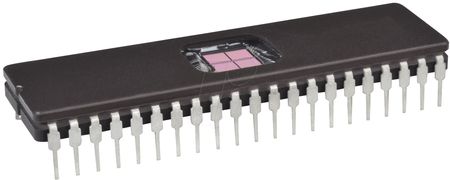
- CMOS UV-EPROM IC
A widely used EPROM is called UV-EPROM, where UV stands for ultraviolet. The only problem with UV-EPROM is that erasing its contents can take up to 20 minutes.
All UV-EPROM chips have a window through which the programmer can shine ultraviolet (UV) radiation to erase the chip’s contents. For this reason, EPROM is also referred to as UV-erasable EPROM or simply UV-EPROM.
Programming a UV-EPROM
To program a UV-EPROM chip, the following steps must be taken:
- Its contents must be erased. To erase a chip, remove it from its socket on the system board and place it in EPROM erasure equipment to expose it to UV radiation for 5-20 minutes.
- Program the chip. To program a UV-EPROM chip, place it in the ROM burner (programmer). To burn code or data into EPROM, the ROM burner uses 12.5 volts or higher, depending on the EPROM type. This voltage is referred to as Vpp in the UV-EPROM datasheet.
- Place the chip back into its socket on the system board.
As can be seen from the above steps, not only is there an EPROM programmer (burner), but there is also separate EPROM erasure equipment.
The main problem, and indeed the major disadvantage of UV-EPROM, is that it cannot be erased and programmed while it is in the system board. To provide a solution to this problem, EEPROM was invented.
3. EEPROM (electrically erasable programmable ROM)
EEPROM has several advantages over EPROM, such as the fact that its method of erasure is electrical and therefore instant as opposed to the 20-minute erasure time required for UV-EPROM.
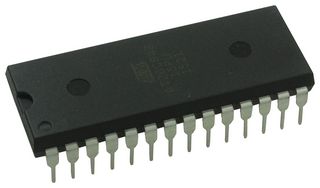
- ATMEL Parallel EEPROM
In addition, in EEPROM one can select which byte to be erased, in contrast to UV-EPROM, in which the entire contents of ROM are erased.
However, the main advantage of EEPROM is that one can program and erase its contents while it is still in the system board. It does not require the physical removal of the memory chip from its socket. In other words, unlike UV-EPROM, EEPROM does not require an external erasure and programming device.
To utilize EEPROM fully, the designer must incorporate the circuitry to program the EEPROM into the system board. In general, the cost per bit for EEPROM is much higher than for UV-EPROM.
4. Flash Memory EPROM
Since the early 1990s, Flash EPROM has become a popular user-programmable memory chip. and for good reasons.
- First, the erasure of the entire contents takes less than a second, or one might say in a flash, hence its name, Flash memory.
- In addition, the erasure method is electrical, and for this reason, it is sometimes referred to as Flash EEPROM. To avoid confusion, it is commonly called Flash memory.
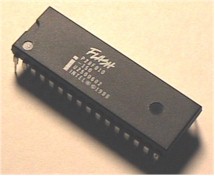
- Flash memory EPROM
The major difference between EEPROM and Flash memory is that when Flash memory’s contents are erased, the entire device is erased, in contrast to EEPROM, where one can erase the desired byte.
Although in many Flash memories recently made available the contents are divided into blocks and the erasure can be done block by block, unlike EEPROM, Flash memory has no byte erasure option.
Because Flash memory can be programmed while it is in its socket on the system board, it is widely used to upgrade the BIOS ROM of the PC. Some designers believe that Flash memory will replace the hard disk as a mass storage medium.
This would increase the performance of the computer tremendously since Flash memory is semiconductor memory with access time in the range of 100ns compared with disk access time in the range of tens of milliseconds. For this to happen, flash memory’s program/erase cycles must become infinite, just like hard disks.
The program/erase cycle refers to the number of times that a chip can be erased and reprogrammed before it becomes unusable. At this time, the program/erase cycle is 100,000 for Flash and EEPROM, 1000 for UV-EPROM, and infinite for RAM and disks.
5. Mask ROM
Mask ROM refers to a type of ROM in which the contents are programmed by the IC manufacturer. In other words, it is not a user-programmable ROM.
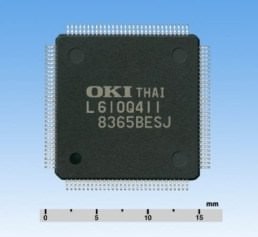
- Mask ROM
The term mask is used in IC fabrication. Since the process is costly, mask ROM is used when the needed volume is high (hundreds of thousands) and it is absolutely certain that the contents will not change.
It is common practice to use UV-EPROM or Flash for the development phase of a project, and only afier the code/data have been finalized is the mask version of the product ordered.
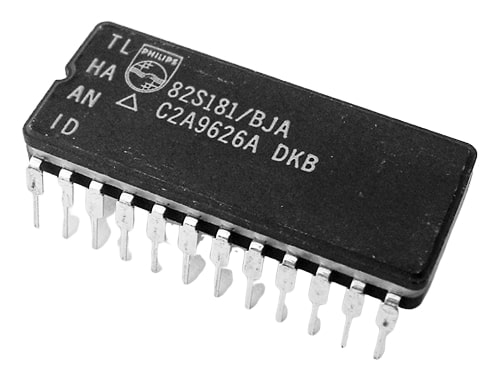
No comments:
Post a Comment